CHCDIV001 Assessment Workbook: UOWCA Diploma of Nursing
VerifiedAdded on 2022/12/29
|86
|15956
|4
Homework Assignment
AI Summary
This document is a comprehensive assessment workbook designed for students enrolled in the HLT54115 Diploma of Nursing program, specifically for the CHCDIV001 unit, which focuses on working with diverse people. The workbook outlines the purpose of the assessment, which is to determine competency in this unit, and provides context and conditions for assessments conducted at the University of Wollongong College Australia (UOWCA). It details the required resources, including textbooks and relevant websites, and lists the assessment tasks, including written questions, case studies, role plays, and workplace assessments. The document provides information on assessment outcomes, marking criteria, and the consequences of unsatisfactory completion. It also includes information on reasonable adjustments, referencing, and plagiarism. The assessment tasks include written questions, a case study, a role play, and a workplace assessment, with specific due dates and locations. The document emphasizes the importance of submitting evidence, adhering to the rules of evidence, and understanding the assessment outcomes, which are categorized as Satisfactory, Not Satisfactory, Competent, or Not Yet Competent. Students are provided with details on how to submit assessments, the marking process, and the right to appeal assessment decisions. The document serves as a guide for students to successfully complete the CHCDIV001 unit and achieve competency in working with diverse people within a healthcare context.
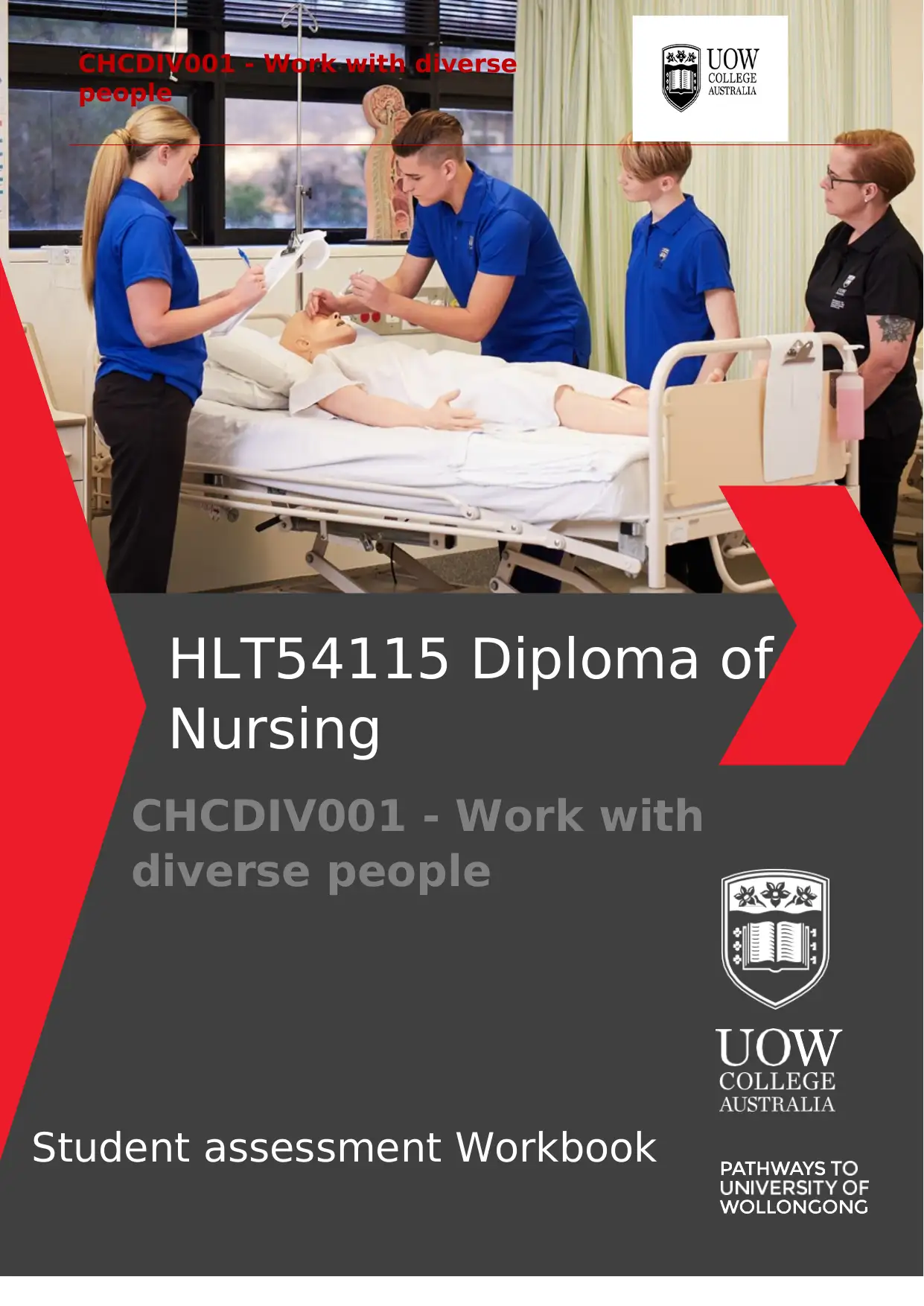
CHCDIV001 Version: 1.4 Responsibility: S. Gannon Last Reviewed: Feb 2019
CHCDIV001 - Work with diverse
people
About this booklet
Page: 1 of 87
HLT54115 Diploma of Nursing
Student Assessment Booklet
HLTWHS002 - Follow safe work practices for
direct client care
__________________________________________
Version no: 1.3
CHCDIV001 - Work with
diverse people
HLT54115 Diploma of
Nursing
Student assessment Workbook
CHCDIV001 - Work with diverse
people
About this booklet
Page: 1 of 87
HLT54115 Diploma of Nursing
Student Assessment Booklet
HLTWHS002 - Follow safe work practices for
direct client care
__________________________________________
Version no: 1.3
CHCDIV001 - Work with
diverse people
HLT54115 Diploma of
Nursing
Student assessment Workbook
Paraphrase This Document
Need a fresh take? Get an instant paraphrase of this document with our AI Paraphraser
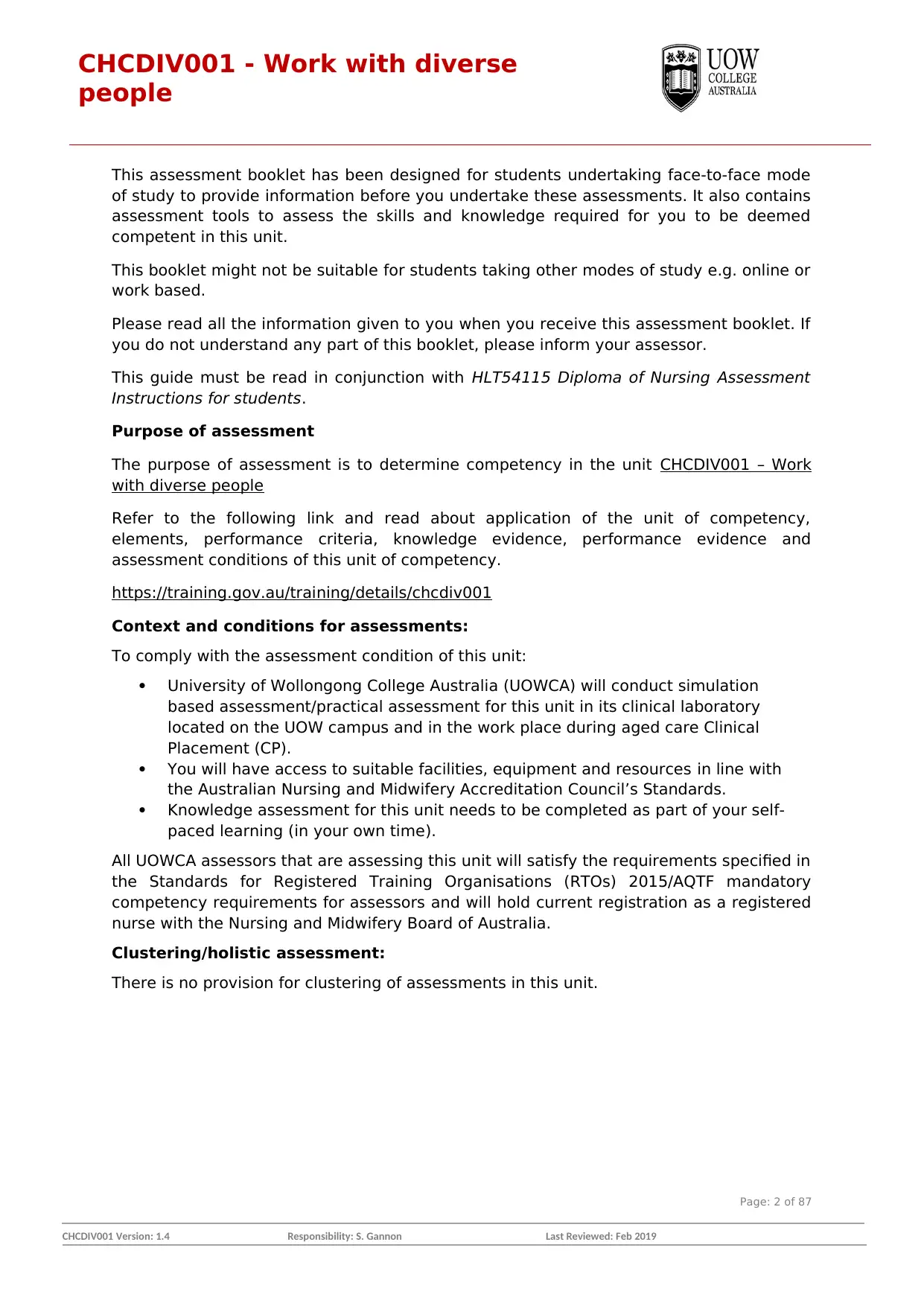
CHCDIV001 Version: 1.4 Responsibility: S. Gannon Last Reviewed: Feb 2019
CHCDIV001 - Work with diverse
people
This assessment booklet has been designed for students undertaking face-to-face mode
of study to provide information before you undertake these assessments. It also contains
assessment tools to assess the skills and knowledge required for you to be deemed
competent in this unit.
This booklet might not be suitable for students taking other modes of study e.g. online or
work based.
Please read all the information given to you when you receive this assessment booklet. If
you do not understand any part of this booklet, please inform your assessor.
This guide must be read in conjunction with HLT54115 Diploma of Nursing Assessment
Instructions for students.
Purpose of assessment
The purpose of assessment is to determine competency in the unit CHCDIV001 – Work
with diverse people
Refer to the following link and read about application of the unit of competency,
elements, performance criteria, knowledge evidence, performance evidence and
assessment conditions of this unit of competency.
https://training.gov.au/training/details/chcdiv001
Context and conditions for assessments:
To comply with the assessment condition of this unit:
University of Wollongong College Australia (UOWCA) will conduct simulation
based assessment/practical assessment for this unit in its clinical laboratory
located on the UOW campus and in the work place during aged care Clinical
Placement (CP).
You will have access to suitable facilities, equipment and resources in line with
the Australian Nursing and Midwifery Accreditation Council’s Standards.
Knowledge assessment for this unit needs to be completed as part of your self-
paced learning (in your own time).
All UOWCA assessors that are assessing this unit will satisfy the requirements specified in
the Standards for Registered Training Organisations (RTOs) 2015/AQTF mandatory
competency requirements for assessors and will hold current registration as a registered
nurse with the Nursing and Midwifery Board of Australia.
Clustering/holistic assessment:
There is no provision for clustering of assessments in this unit.
Page: 2 of 87
CHCDIV001 - Work with diverse
people
This assessment booklet has been designed for students undertaking face-to-face mode
of study to provide information before you undertake these assessments. It also contains
assessment tools to assess the skills and knowledge required for you to be deemed
competent in this unit.
This booklet might not be suitable for students taking other modes of study e.g. online or
work based.
Please read all the information given to you when you receive this assessment booklet. If
you do not understand any part of this booklet, please inform your assessor.
This guide must be read in conjunction with HLT54115 Diploma of Nursing Assessment
Instructions for students.
Purpose of assessment
The purpose of assessment is to determine competency in the unit CHCDIV001 – Work
with diverse people
Refer to the following link and read about application of the unit of competency,
elements, performance criteria, knowledge evidence, performance evidence and
assessment conditions of this unit of competency.
https://training.gov.au/training/details/chcdiv001
Context and conditions for assessments:
To comply with the assessment condition of this unit:
University of Wollongong College Australia (UOWCA) will conduct simulation
based assessment/practical assessment for this unit in its clinical laboratory
located on the UOW campus and in the work place during aged care Clinical
Placement (CP).
You will have access to suitable facilities, equipment and resources in line with
the Australian Nursing and Midwifery Accreditation Council’s Standards.
Knowledge assessment for this unit needs to be completed as part of your self-
paced learning (in your own time).
All UOWCA assessors that are assessing this unit will satisfy the requirements specified in
the Standards for Registered Training Organisations (RTOs) 2015/AQTF mandatory
competency requirements for assessors and will hold current registration as a registered
nurse with the Nursing and Midwifery Board of Australia.
Clustering/holistic assessment:
There is no provision for clustering of assessments in this unit.
Page: 2 of 87
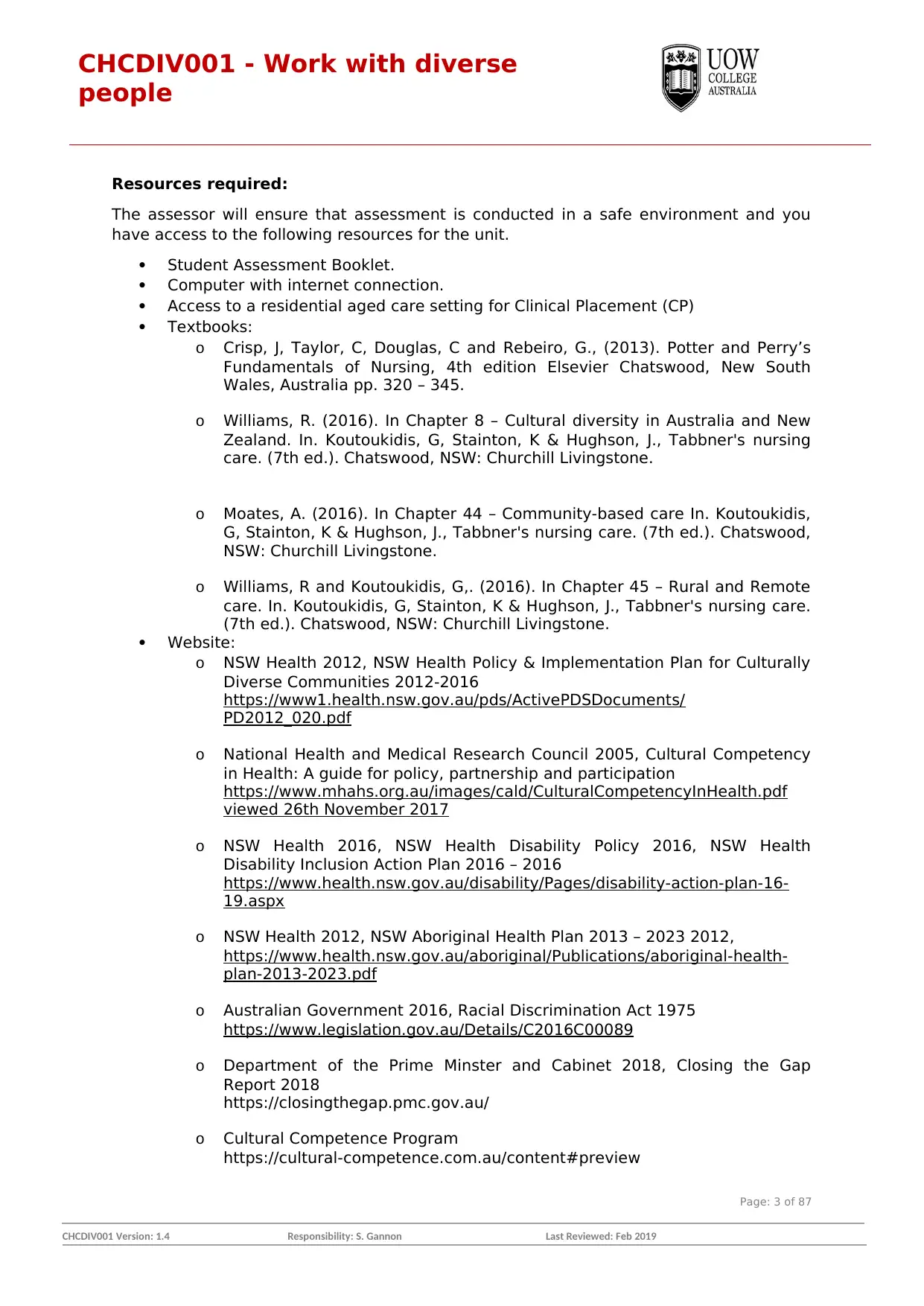
CHCDIV001 Version: 1.4 Responsibility: S. Gannon Last Reviewed: Feb 2019
CHCDIV001 - Work with diverse
people
Resources required:
The assessor will ensure that assessment is conducted in a safe environment and you
have access to the following resources for the unit.
Student Assessment Booklet.
Computer with internet connection.
Access to a residential aged care setting for Clinical Placement (CP)
Textbooks:
o Crisp, J, Taylor, C, Douglas, C and Rebeiro, G., (2013). Potter and Perry’s
Fundamentals of Nursing, 4th edition Elsevier Chatswood, New South
Wales, Australia pp. 320 – 345.
o Williams, R. (2016). In Chapter 8 – Cultural diversity in Australia and New
Zealand. In. Koutoukidis, G, Stainton, K & Hughson, J., Tabbner's nursing
care. (7th ed.). Chatswood, NSW: Churchill Livingstone.
o Moates, A. (2016). In Chapter 44 – Community-based care In. Koutoukidis,
G, Stainton, K & Hughson, J., Tabbner's nursing care. (7th ed.). Chatswood,
NSW: Churchill Livingstone.
o Williams, R and Koutoukidis, G,. (2016). In Chapter 45 – Rural and Remote
care. In. Koutoukidis, G, Stainton, K & Hughson, J., Tabbner's nursing care.
(7th ed.). Chatswood, NSW: Churchill Livingstone.
Website:
o NSW Health 2012, NSW Health Policy & Implementation Plan for Culturally
Diverse Communities 2012-2016
https://www1.health.nsw.gov.au/pds/ActivePDSDocuments/
PD2012_020.pdf
o National Health and Medical Research Council 2005, Cultural Competency
in Health: A guide for policy, partnership and participation
https://www.mhahs.org.au/images/cald/CulturalCompetencyInHealth.pdf
viewed 26th November 2017
o NSW Health 2016, NSW Health Disability Policy 2016, NSW Health
Disability Inclusion Action Plan 2016 – 2016
https://www.health.nsw.gov.au/disability/Pages/disability-action-plan-16-
19.aspx
o NSW Health 2012, NSW Aboriginal Health Plan 2013 – 2023 2012,
https://www.health.nsw.gov.au/aboriginal/Publications/aboriginal-health-
plan-2013-2023.pdf
o Australian Government 2016, Racial Discrimination Act 1975
https://www.legislation.gov.au/Details/C2016C00089
o Department of the Prime Minster and Cabinet 2018, Closing the Gap
Report 2018
https://closingthegap.pmc.gov.au/
o Cultural Competence Program
https://cultural-competence.com.au/content#preview
Page: 3 of 87
CHCDIV001 - Work with diverse
people
Resources required:
The assessor will ensure that assessment is conducted in a safe environment and you
have access to the following resources for the unit.
Student Assessment Booklet.
Computer with internet connection.
Access to a residential aged care setting for Clinical Placement (CP)
Textbooks:
o Crisp, J, Taylor, C, Douglas, C and Rebeiro, G., (2013). Potter and Perry’s
Fundamentals of Nursing, 4th edition Elsevier Chatswood, New South
Wales, Australia pp. 320 – 345.
o Williams, R. (2016). In Chapter 8 – Cultural diversity in Australia and New
Zealand. In. Koutoukidis, G, Stainton, K & Hughson, J., Tabbner's nursing
care. (7th ed.). Chatswood, NSW: Churchill Livingstone.
o Moates, A. (2016). In Chapter 44 – Community-based care In. Koutoukidis,
G, Stainton, K & Hughson, J., Tabbner's nursing care. (7th ed.). Chatswood,
NSW: Churchill Livingstone.
o Williams, R and Koutoukidis, G,. (2016). In Chapter 45 – Rural and Remote
care. In. Koutoukidis, G, Stainton, K & Hughson, J., Tabbner's nursing care.
(7th ed.). Chatswood, NSW: Churchill Livingstone.
Website:
o NSW Health 2012, NSW Health Policy & Implementation Plan for Culturally
Diverse Communities 2012-2016
https://www1.health.nsw.gov.au/pds/ActivePDSDocuments/
PD2012_020.pdf
o National Health and Medical Research Council 2005, Cultural Competency
in Health: A guide for policy, partnership and participation
https://www.mhahs.org.au/images/cald/CulturalCompetencyInHealth.pdf
viewed 26th November 2017
o NSW Health 2016, NSW Health Disability Policy 2016, NSW Health
Disability Inclusion Action Plan 2016 – 2016
https://www.health.nsw.gov.au/disability/Pages/disability-action-plan-16-
19.aspx
o NSW Health 2012, NSW Aboriginal Health Plan 2013 – 2023 2012,
https://www.health.nsw.gov.au/aboriginal/Publications/aboriginal-health-
plan-2013-2023.pdf
o Australian Government 2016, Racial Discrimination Act 1975
https://www.legislation.gov.au/Details/C2016C00089
o Department of the Prime Minster and Cabinet 2018, Closing the Gap
Report 2018
https://closingthegap.pmc.gov.au/
o Cultural Competence Program
https://cultural-competence.com.au/content#preview
Page: 3 of 87
⊘ This is a preview!⊘
Do you want full access?
Subscribe today to unlock all pages.

Trusted by 1+ million students worldwide
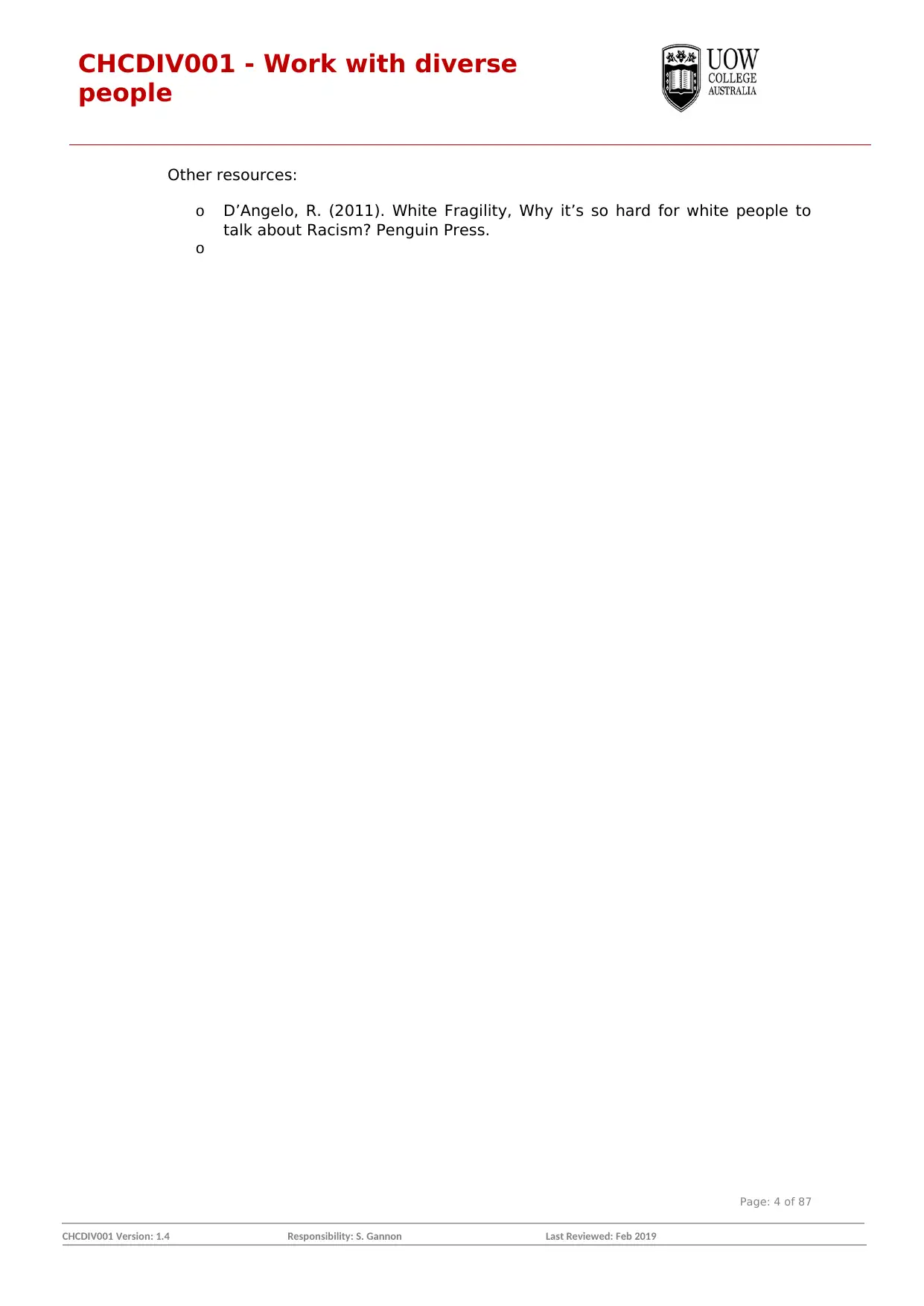
CHCDIV001 Version: 1.4 Responsibility: S. Gannon Last Reviewed: Feb 2019
CHCDIV001 - Work with diverse
people
Other resources:
o D’Angelo, R. (2011). White Fragility, Why it’s so hard for white people to
talk about Racism? Penguin Press.
o
Page: 4 of 87
CHCDIV001 - Work with diverse
people
Other resources:
o D’Angelo, R. (2011). White Fragility, Why it’s so hard for white people to
talk about Racism? Penguin Press.
o
Page: 4 of 87
Paraphrase This Document
Need a fresh take? Get an instant paraphrase of this document with our AI Paraphraser
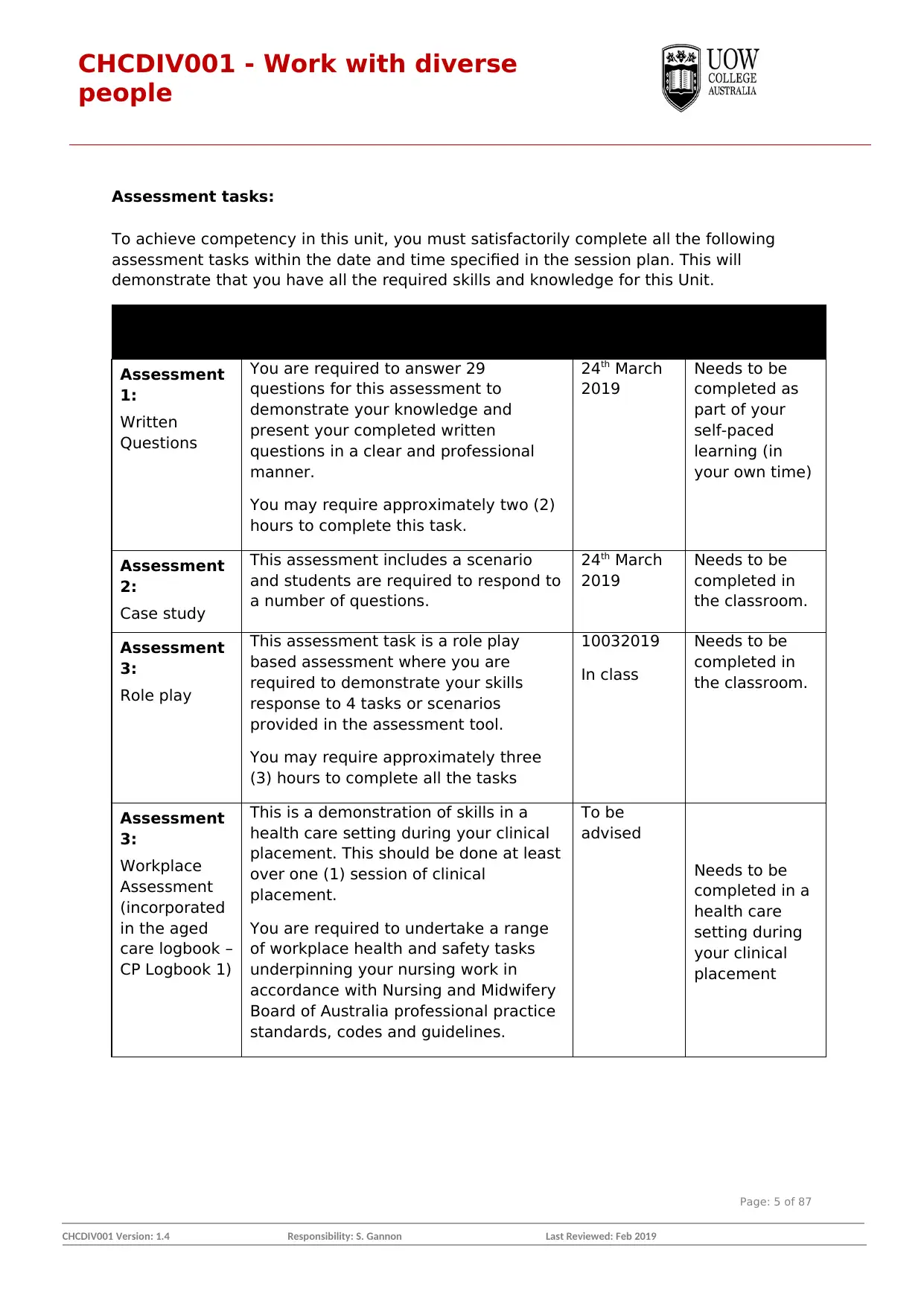
CHCDIV001 Version: 1.4 Responsibility: S. Gannon Last Reviewed: Feb 2019
CHCDIV001 - Work with diverse
people
Assessment tasks:
To achieve competency in this unit, you must satisfactorily complete all the following
assessment tasks within the date and time specified in the session plan. This will
demonstrate that you have all the required skills and knowledge for this Unit.
Assessment
tasks
Assessment description Due date Location of
assessment
Assessment
1:
Written
Questions
You are required to answer 29
questions for this assessment to
demonstrate your knowledge and
present your completed written
questions in a clear and professional
manner.
You may require approximately two (2)
hours to complete this task.
24th March
2019
Needs to be
completed as
part of your
self-paced
learning (in
your own time)
Assessment
2:
Case study
This assessment includes a scenario
and students are required to respond to
a number of questions.
24th March
2019
Needs to be
completed in
the classroom.
Assessment
3:
Role play
This assessment task is a role play
based assessment where you are
required to demonstrate your skills
response to 4 tasks or scenarios
provided in the assessment tool.
You may require approximately three
(3) hours to complete all the tasks
10032019
In class
Needs to be
completed in
the classroom.
Assessment
3:
Workplace
Assessment
(incorporated
in the aged
care logbook –
CP Logbook 1)
This is a demonstration of skills in a
health care setting during your clinical
placement. This should be done at least
over one (1) session of clinical
placement.
You are required to undertake a range
of workplace health and safety tasks
underpinning your nursing work in
accordance with Nursing and Midwifery
Board of Australia professional practice
standards, codes and guidelines.
To be
advised
Needs to be
completed in a
health care
setting during
your clinical
placement
Page: 5 of 87
CHCDIV001 - Work with diverse
people
Assessment tasks:
To achieve competency in this unit, you must satisfactorily complete all the following
assessment tasks within the date and time specified in the session plan. This will
demonstrate that you have all the required skills and knowledge for this Unit.
Assessment
tasks
Assessment description Due date Location of
assessment
Assessment
1:
Written
Questions
You are required to answer 29
questions for this assessment to
demonstrate your knowledge and
present your completed written
questions in a clear and professional
manner.
You may require approximately two (2)
hours to complete this task.
24th March
2019
Needs to be
completed as
part of your
self-paced
learning (in
your own time)
Assessment
2:
Case study
This assessment includes a scenario
and students are required to respond to
a number of questions.
24th March
2019
Needs to be
completed in
the classroom.
Assessment
3:
Role play
This assessment task is a role play
based assessment where you are
required to demonstrate your skills
response to 4 tasks or scenarios
provided in the assessment tool.
You may require approximately three
(3) hours to complete all the tasks
10032019
In class
Needs to be
completed in
the classroom.
Assessment
3:
Workplace
Assessment
(incorporated
in the aged
care logbook –
CP Logbook 1)
This is a demonstration of skills in a
health care setting during your clinical
placement. This should be done at least
over one (1) session of clinical
placement.
You are required to undertake a range
of workplace health and safety tasks
underpinning your nursing work in
accordance with Nursing and Midwifery
Board of Australia professional practice
standards, codes and guidelines.
To be
advised
Needs to be
completed in a
health care
setting during
your clinical
placement
Page: 5 of 87
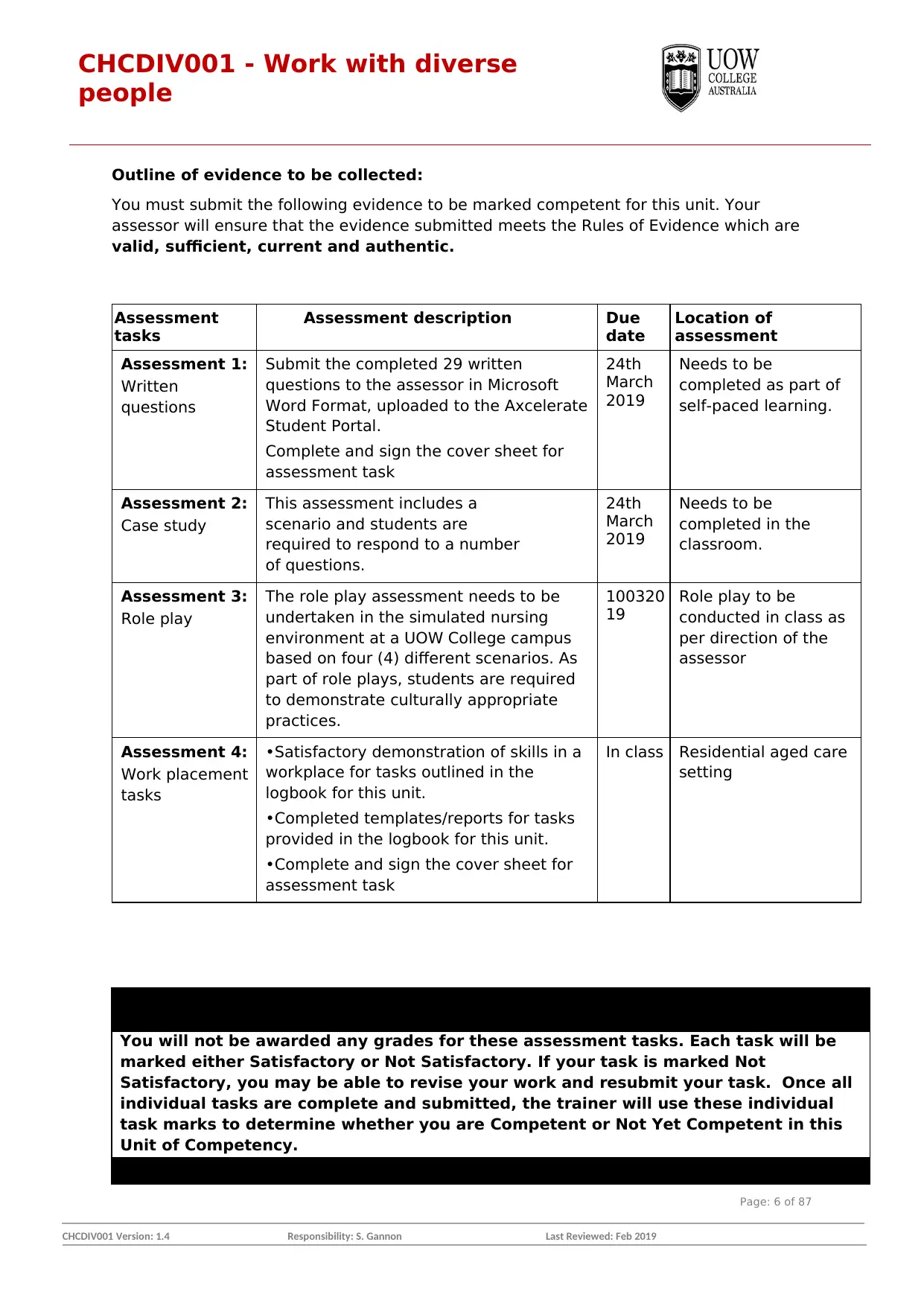
CHCDIV001 Version: 1.4 Responsibility: S. Gannon Last Reviewed: Feb 2019
CHCDIV001 - Work with diverse
people
Outline of evidence to be collected:
You must submit the following evidence to be marked competent for this unit. Your
assessor will ensure that the evidence submitted meets the Rules of Evidence which are
valid, sufficient, current and authentic.
Assessment
tasks
Assessment description Due
date
Location of
assessment
Assessment 1:
Written
questions
Submit the completed 29 written
questions to the assessor in Microsoft
Word Format, uploaded to the Axcelerate
Student Portal.
Complete and sign the cover sheet for
assessment task
24th
March
2019
Needs to be
completed as part of
self-paced learning.
Assessment 2:
Case study
This assessment includes a
scenario and students are
required to respond to a number
of questions.
24th
March
2019
Needs to be
completed in the
classroom.
Assessment 3:
Role play
The role play assessment needs to be
undertaken in the simulated nursing
environment at a UOW College campus
based on four (4) different scenarios. As
part of role plays, students are required
to demonstrate culturally appropriate
practices.
100320
19
Role play to be
conducted in class as
per direction of the
assessor
Assessment 4:
Work placement
tasks
•Satisfactory demonstration of skills in a
workplace for tasks outlined in the
logbook for this unit.
•Completed templates/reports for tasks
provided in the logbook for this unit.
•Complete and sign the cover sheet for
assessment task
In class Residential aged care
setting
Assessment outcomes
You will not be awarded any grades for these assessment tasks. Each task will be
marked either Satisfactory or Not Satisfactory. If your task is marked Not
Satisfactory, you may be able to revise your work and resubmit your task. Once all
individual tasks are complete and submitted, the trainer will use these individual
task marks to determine whether you are Competent or Not Yet Competent in this
Unit of Competency.
Result Code What this result means
Page: 6 of 87
CHCDIV001 - Work with diverse
people
Outline of evidence to be collected:
You must submit the following evidence to be marked competent for this unit. Your
assessor will ensure that the evidence submitted meets the Rules of Evidence which are
valid, sufficient, current and authentic.
Assessment
tasks
Assessment description Due
date
Location of
assessment
Assessment 1:
Written
questions
Submit the completed 29 written
questions to the assessor in Microsoft
Word Format, uploaded to the Axcelerate
Student Portal.
Complete and sign the cover sheet for
assessment task
24th
March
2019
Needs to be
completed as part of
self-paced learning.
Assessment 2:
Case study
This assessment includes a
scenario and students are
required to respond to a number
of questions.
24th
March
2019
Needs to be
completed in the
classroom.
Assessment 3:
Role play
The role play assessment needs to be
undertaken in the simulated nursing
environment at a UOW College campus
based on four (4) different scenarios. As
part of role plays, students are required
to demonstrate culturally appropriate
practices.
100320
19
Role play to be
conducted in class as
per direction of the
assessor
Assessment 4:
Work placement
tasks
•Satisfactory demonstration of skills in a
workplace for tasks outlined in the
logbook for this unit.
•Completed templates/reports for tasks
provided in the logbook for this unit.
•Complete and sign the cover sheet for
assessment task
In class Residential aged care
setting
Assessment outcomes
You will not be awarded any grades for these assessment tasks. Each task will be
marked either Satisfactory or Not Satisfactory. If your task is marked Not
Satisfactory, you may be able to revise your work and resubmit your task. Once all
individual tasks are complete and submitted, the trainer will use these individual
task marks to determine whether you are Competent or Not Yet Competent in this
Unit of Competency.
Result Code What this result means
Page: 6 of 87
⊘ This is a preview!⊘
Do you want full access?
Subscribe today to unlock all pages.

Trusted by 1+ million students worldwide
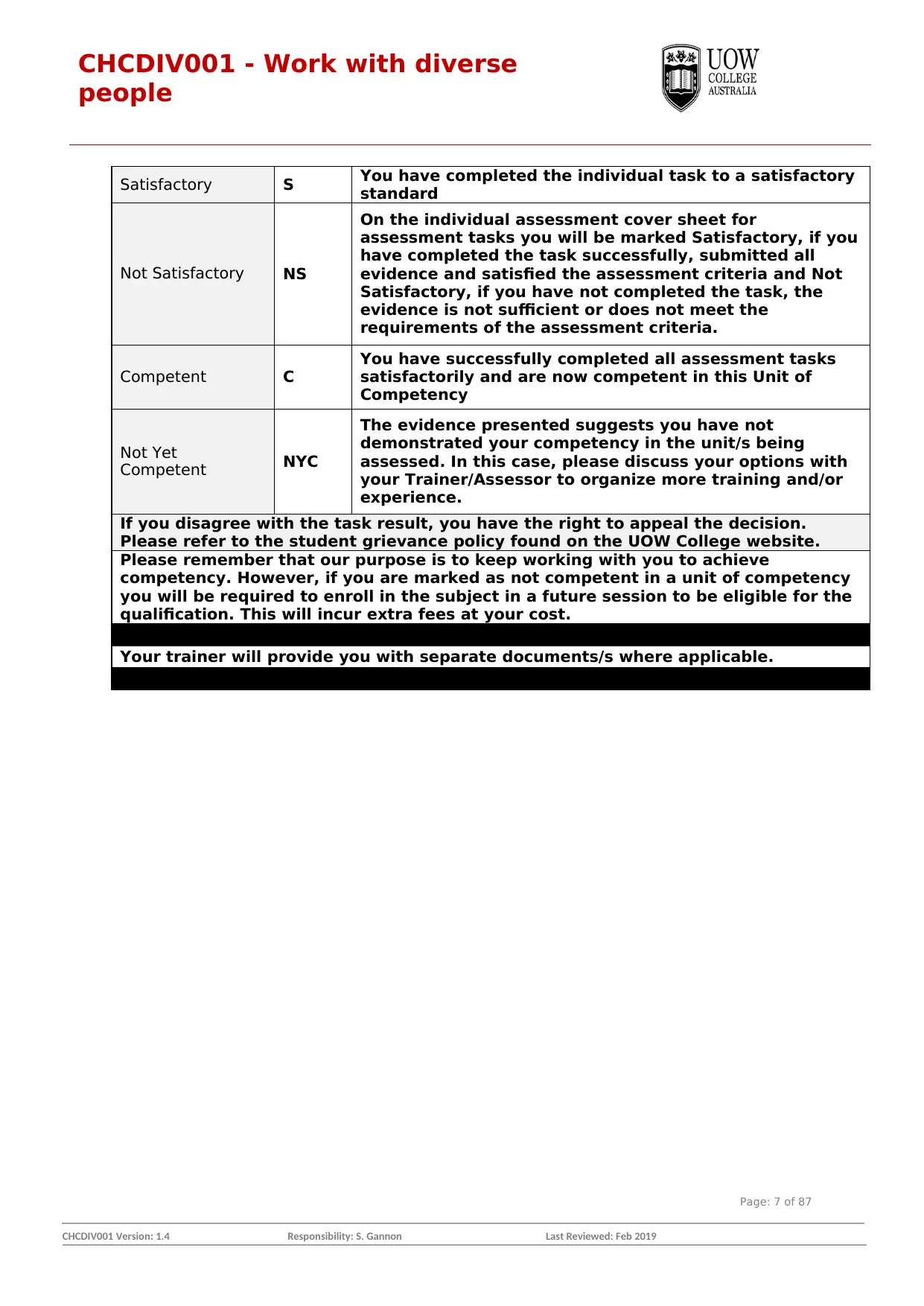
CHCDIV001 Version: 1.4 Responsibility: S. Gannon Last Reviewed: Feb 2019
CHCDIV001 - Work with diverse
people
Satisfactory S You have completed the individual task to a satisfactory
standard
Not Satisfactory NS
On the individual assessment cover sheet for
assessment tasks you will be marked Satisfactory, if you
have completed the task successfully, submitted all
evidence and satisfied the assessment criteria and Not
Satisfactory, if you have not completed the task, the
evidence is not sufficient or does not meet the
requirements of the assessment criteria.
Competent C
You have successfully completed all assessment tasks
satisfactorily and are now competent in this Unit of
Competency
Not Yet
Competent NYC
The evidence presented suggests you have not
demonstrated your competency in the unit/s being
assessed. In this case, please discuss your options with
your Trainer/Assessor to organize more training and/or
experience.
If you disagree with the task result, you have the right to appeal the decision.
Please refer to the student grievance policy found on the UOW College website.
Please remember that our purpose is to keep working with you to achieve
competency. However, if you are marked as not competent in a unit of competency
you will be required to enroll in the subject in a future session to be eligible for the
qualification. This will incur extra fees at your cost.
Information on Work placement
Your trainer will provide you with separate documents/s where applicable.
Reasonable Adjustments
Page: 7 of 87
CHCDIV001 - Work with diverse
people
Satisfactory S You have completed the individual task to a satisfactory
standard
Not Satisfactory NS
On the individual assessment cover sheet for
assessment tasks you will be marked Satisfactory, if you
have completed the task successfully, submitted all
evidence and satisfied the assessment criteria and Not
Satisfactory, if you have not completed the task, the
evidence is not sufficient or does not meet the
requirements of the assessment criteria.
Competent C
You have successfully completed all assessment tasks
satisfactorily and are now competent in this Unit of
Competency
Not Yet
Competent NYC
The evidence presented suggests you have not
demonstrated your competency in the unit/s being
assessed. In this case, please discuss your options with
your Trainer/Assessor to organize more training and/or
experience.
If you disagree with the task result, you have the right to appeal the decision.
Please refer to the student grievance policy found on the UOW College website.
Please remember that our purpose is to keep working with you to achieve
competency. However, if you are marked as not competent in a unit of competency
you will be required to enroll in the subject in a future session to be eligible for the
qualification. This will incur extra fees at your cost.
Information on Work placement
Your trainer will provide you with separate documents/s where applicable.
Reasonable Adjustments
Page: 7 of 87
Paraphrase This Document
Need a fresh take? Get an instant paraphrase of this document with our AI Paraphraser
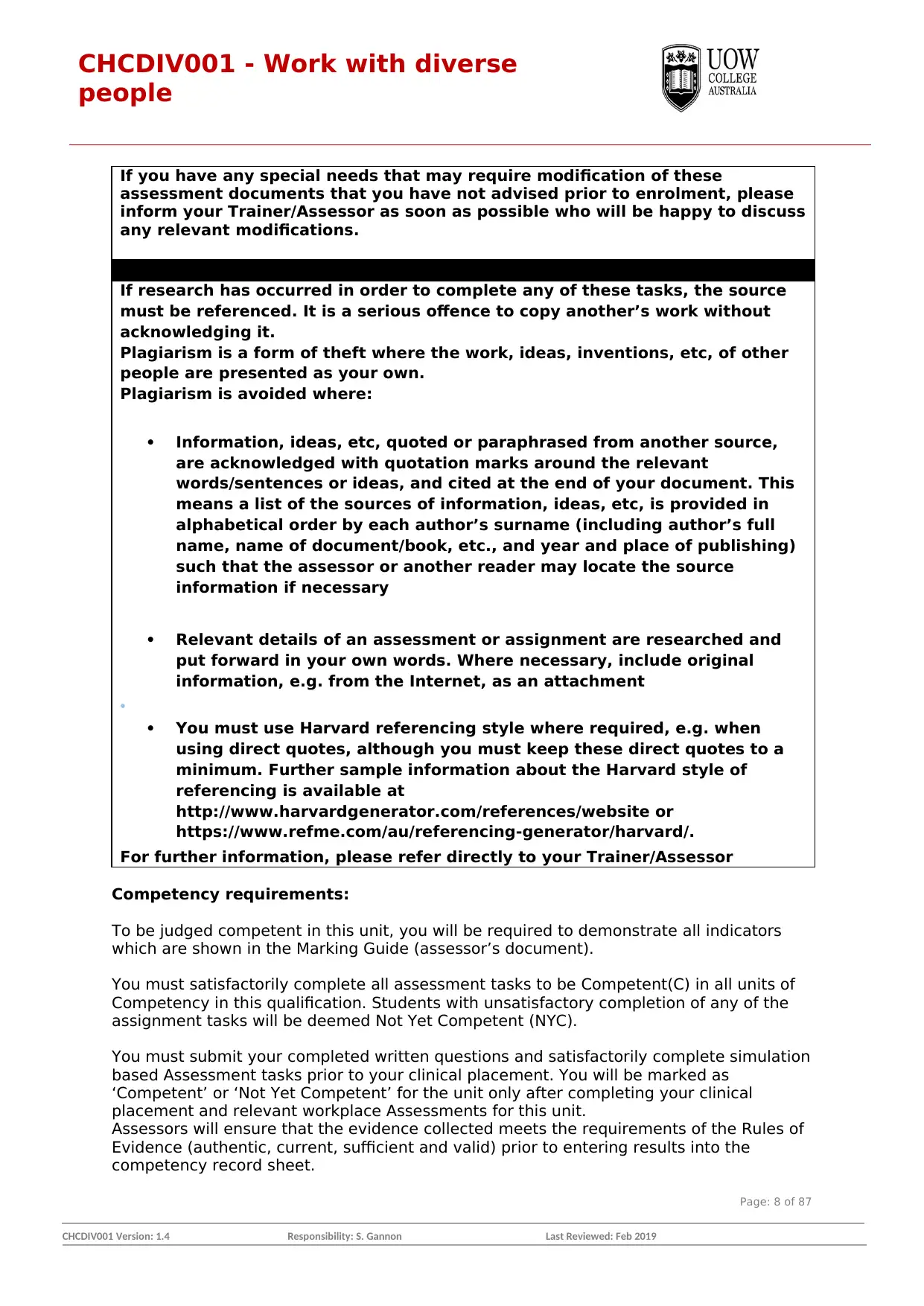
CHCDIV001 Version: 1.4 Responsibility: S. Gannon Last Reviewed: Feb 2019
CHCDIV001 - Work with diverse
people
If you have any special needs that may require modification of these
assessment documents that you have not advised prior to enrolment, please
inform your Trainer/Assessor as soon as possible who will be happy to discuss
any relevant modifications.
Referencing and Plagiarism
If research has occurred in order to complete any of these tasks, the source
must be referenced. It is a serious offence to copy another’s work without
acknowledging it.
Plagiarism is a form of theft where the work, ideas, inventions, etc, of other
people are presented as your own.
Plagiarism is avoided where:
Information, ideas, etc, quoted or paraphrased from another source,
are acknowledged with quotation marks around the relevant
words/sentences or ideas, and cited at the end of your document. This
means a list of the sources of information, ideas, etc, is provided in
alphabetical order by each author’s surname (including author’s full
name, name of document/book, etc., and year and place of publishing)
such that the assessor or another reader may locate the source
information if necessary
Relevant details of an assessment or assignment are researched and
put forward in your own words. Where necessary, include original
information, e.g. from the Internet, as an attachment
•
You must use Harvard referencing style where required, e.g. when
using direct quotes, although you must keep these direct quotes to a
minimum. Further sample information about the Harvard style of
referencing is available at
http://www.harvardgenerator.com/references/website or
https://www.refme.com/au/referencing-generator/harvard/.
For further information, please refer directly to your Trainer/Assessor
Competency requirements:
To be judged competent in this unit, you will be required to demonstrate all indicators
which are shown in the Marking Guide (assessor’s document).
You must satisfactorily complete all assessment tasks to be Competent(C) in all units of
Competency in this qualification. Students with unsatisfactory completion of any of the
assignment tasks will be deemed Not Yet Competent (NYC).
You must submit your completed written questions and satisfactorily complete simulation
based Assessment tasks prior to your clinical placement. You will be marked as
‘Competent’ or ‘Not Yet Competent’ for the unit only after completing your clinical
placement and relevant workplace Assessments for this unit.
Assessors will ensure that the evidence collected meets the requirements of the Rules of
Evidence (authentic, current, sufficient and valid) prior to entering results into the
competency record sheet.
Page: 8 of 87
CHCDIV001 - Work with diverse
people
If you have any special needs that may require modification of these
assessment documents that you have not advised prior to enrolment, please
inform your Trainer/Assessor as soon as possible who will be happy to discuss
any relevant modifications.
Referencing and Plagiarism
If research has occurred in order to complete any of these tasks, the source
must be referenced. It is a serious offence to copy another’s work without
acknowledging it.
Plagiarism is a form of theft where the work, ideas, inventions, etc, of other
people are presented as your own.
Plagiarism is avoided where:
Information, ideas, etc, quoted or paraphrased from another source,
are acknowledged with quotation marks around the relevant
words/sentences or ideas, and cited at the end of your document. This
means a list of the sources of information, ideas, etc, is provided in
alphabetical order by each author’s surname (including author’s full
name, name of document/book, etc., and year and place of publishing)
such that the assessor or another reader may locate the source
information if necessary
Relevant details of an assessment or assignment are researched and
put forward in your own words. Where necessary, include original
information, e.g. from the Internet, as an attachment
•
You must use Harvard referencing style where required, e.g. when
using direct quotes, although you must keep these direct quotes to a
minimum. Further sample information about the Harvard style of
referencing is available at
http://www.harvardgenerator.com/references/website or
https://www.refme.com/au/referencing-generator/harvard/.
For further information, please refer directly to your Trainer/Assessor
Competency requirements:
To be judged competent in this unit, you will be required to demonstrate all indicators
which are shown in the Marking Guide (assessor’s document).
You must satisfactorily complete all assessment tasks to be Competent(C) in all units of
Competency in this qualification. Students with unsatisfactory completion of any of the
assignment tasks will be deemed Not Yet Competent (NYC).
You must submit your completed written questions and satisfactorily complete simulation
based Assessment tasks prior to your clinical placement. You will be marked as
‘Competent’ or ‘Not Yet Competent’ for the unit only after completing your clinical
placement and relevant workplace Assessments for this unit.
Assessors will ensure that the evidence collected meets the requirements of the Rules of
Evidence (authentic, current, sufficient and valid) prior to entering results into the
competency record sheet.
Page: 8 of 87

CHCDIV001 Version: 1.4 Responsibility: S. Gannon Last Reviewed: Feb 2019
CHCDIV001 - Work with diverse
people
Students unsuccessful at achieving “Satisfactory” for any assessment at the first attempt
will be given one opportunity for reassessment. If the student is still deemed Not Yet
Satisfactory (NYS) after two attempts at any assessment forming part of this unit, the
student will be required to repeat the unit as per the scheduled delivery of the course.
For further details, refer to UOWCA Assessment Policy and UOWCA Progression Policy
and Procedure.
Administration, recording and reporting requirements:
You must read and follow this information carefully while completing assessments for this
unit of Competency and if you are unsure of any instruction, please contact your
trainer/assessor to clarify.
The assessments are intended to be equitable, fair and flexible.
Submission of assessment:
You must ensure that the completed assessment tasks are submitted along with the
assessment coversheet:
Your assessor will mark the submitted assessment, provide feedback to you and
complete the comments section against each task, where applicable.
ALL tasks must be completed in legible English. Assessments must be typed and
submitted to the Axcelerate Learning Student Platform.
You must submit all assessments on or before the due date specified by the assessor as
per the training plan.
Extensions for individual assessment tasks may be negotiated in specific circumstances
with your assessor/trainer. The learner needs to provide genuine evidence documents
when seeking an extension to due date (e.g. Extensions due to illness will require a
medical certificate).To arrange an extension, you must speak to your assessor prior to
the due date. Extensions must be confirmed by the trainer in writing.
You are permitted to use dictionaries and to seek support, as required.
Unless the assessment task specifically allows pair work or group activities such as
brainstorming, you must submit your own original work and must not copy the work of
other students. Plagiarism is unacceptable.
Assessment tasks are submitted through the learning management system and for
clinical workbooks hand in hard copies in the classroom.
Assessment Cover Sheet: Assessment Task 1 (AT1)
Student Detail
Page: 9 of 87
CHCDIV001 - Work with diverse
people
Students unsuccessful at achieving “Satisfactory” for any assessment at the first attempt
will be given one opportunity for reassessment. If the student is still deemed Not Yet
Satisfactory (NYS) after two attempts at any assessment forming part of this unit, the
student will be required to repeat the unit as per the scheduled delivery of the course.
For further details, refer to UOWCA Assessment Policy and UOWCA Progression Policy
and Procedure.
Administration, recording and reporting requirements:
You must read and follow this information carefully while completing assessments for this
unit of Competency and if you are unsure of any instruction, please contact your
trainer/assessor to clarify.
The assessments are intended to be equitable, fair and flexible.
Submission of assessment:
You must ensure that the completed assessment tasks are submitted along with the
assessment coversheet:
Your assessor will mark the submitted assessment, provide feedback to you and
complete the comments section against each task, where applicable.
ALL tasks must be completed in legible English. Assessments must be typed and
submitted to the Axcelerate Learning Student Platform.
You must submit all assessments on or before the due date specified by the assessor as
per the training plan.
Extensions for individual assessment tasks may be negotiated in specific circumstances
with your assessor/trainer. The learner needs to provide genuine evidence documents
when seeking an extension to due date (e.g. Extensions due to illness will require a
medical certificate).To arrange an extension, you must speak to your assessor prior to
the due date. Extensions must be confirmed by the trainer in writing.
You are permitted to use dictionaries and to seek support, as required.
Unless the assessment task specifically allows pair work or group activities such as
brainstorming, you must submit your own original work and must not copy the work of
other students. Plagiarism is unacceptable.
Assessment tasks are submitted through the learning management system and for
clinical workbooks hand in hard copies in the classroom.
Assessment Cover Sheet: Assessment Task 1 (AT1)
Student Detail
Page: 9 of 87
⊘ This is a preview!⊘
Do you want full access?
Subscribe today to unlock all pages.

Trusted by 1+ million students worldwide
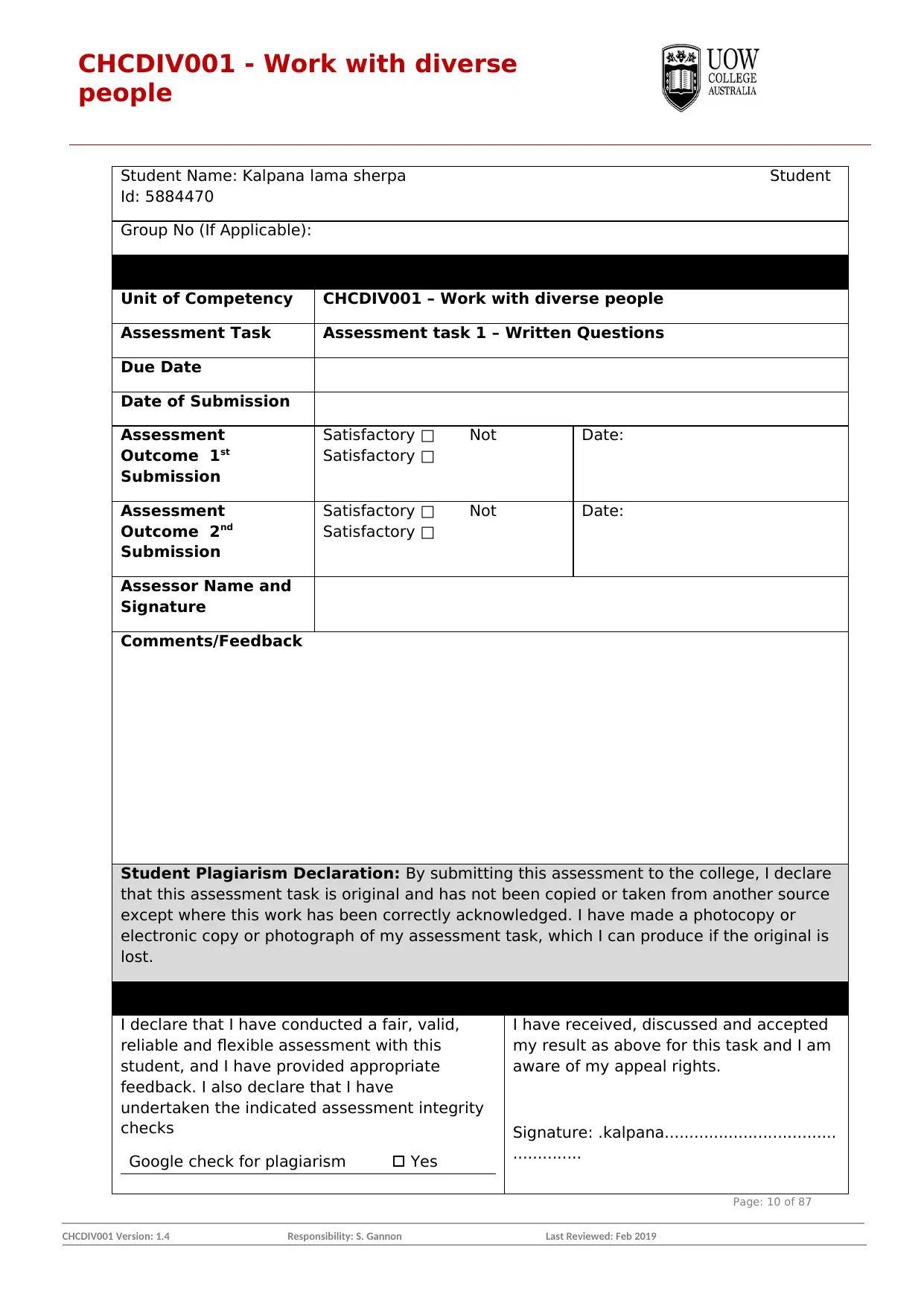
CHCDIV001 Version: 1.4 Responsibility: S. Gannon Last Reviewed: Feb 2019
CHCDIV001 - Work with diverse
people
Student Name: Kalpana lama sherpa Student
Id: 5884470
Group No (If Applicable):
Assessment Details
Unit of Competency CHCDIV001 – Work with diverse people
Assessment Task Assessment task 1 – Written Questions
Due Date
Date of Submission
Assessment
Outcome 1st
Submission
Satisfactory □ Not
Satisfactory □
Date:
Assessment
Outcome 2nd
Submission
Satisfactory □ Not
Satisfactory □
Date:
Assessor Name and
Signature
Comments/Feedback
Student Plagiarism Declaration: By submitting this assessment to the college, I declare
that this assessment task is original and has not been copied or taken from another source
except where this work has been correctly acknowledged. I have made a photocopy or
electronic copy or photograph of my assessment task, which I can produce if the original is
lost.
Assessor Student
I declare that I have conducted a fair, valid,
reliable and flexible assessment with this
student, and I have provided appropriate
feedback. I also declare that I have
undertaken the indicated assessment integrity
checks
Google check for plagiarism Yes
I have received, discussed and accepted
my result as above for this task and I am
aware of my appeal rights.
Signature: .kalpana...................................
..............
Page: 10 of 87
CHCDIV001 - Work with diverse
people
Student Name: Kalpana lama sherpa Student
Id: 5884470
Group No (If Applicable):
Assessment Details
Unit of Competency CHCDIV001 – Work with diverse people
Assessment Task Assessment task 1 – Written Questions
Due Date
Date of Submission
Assessment
Outcome 1st
Submission
Satisfactory □ Not
Satisfactory □
Date:
Assessment
Outcome 2nd
Submission
Satisfactory □ Not
Satisfactory □
Date:
Assessor Name and
Signature
Comments/Feedback
Student Plagiarism Declaration: By submitting this assessment to the college, I declare
that this assessment task is original and has not been copied or taken from another source
except where this work has been correctly acknowledged. I have made a photocopy or
electronic copy or photograph of my assessment task, which I can produce if the original is
lost.
Assessor Student
I declare that I have conducted a fair, valid,
reliable and flexible assessment with this
student, and I have provided appropriate
feedback. I also declare that I have
undertaken the indicated assessment integrity
checks
Google check for plagiarism Yes
I have received, discussed and accepted
my result as above for this task and I am
aware of my appeal rights.
Signature: .kalpana...................................
..............
Page: 10 of 87
Paraphrase This Document
Need a fresh take? Get an instant paraphrase of this document with our AI Paraphraser
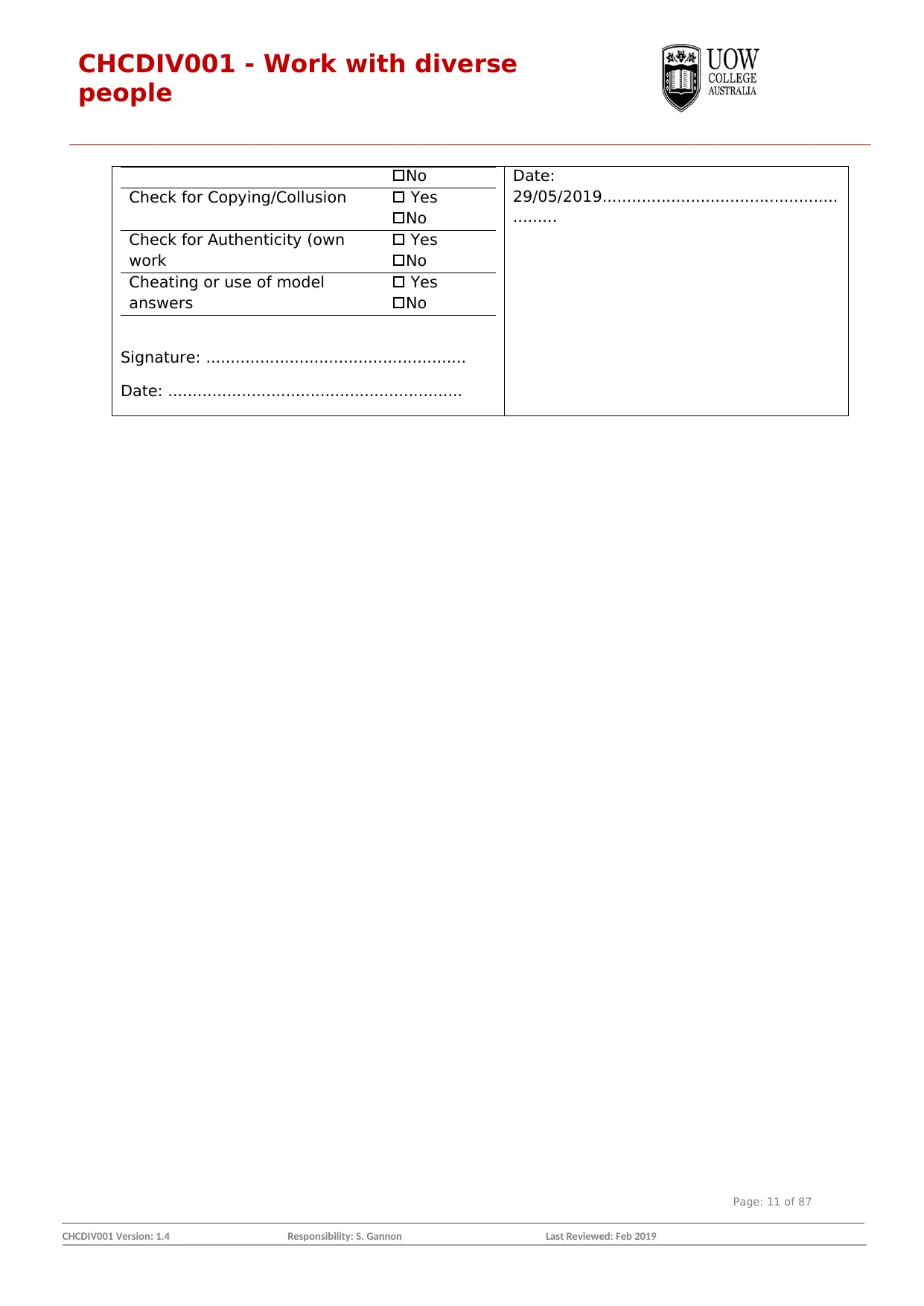
CHCDIV001 Version: 1.4 Responsibility: S. Gannon Last Reviewed: Feb 2019
CHCDIV001 - Work with diverse
people
No
Check for Copying/Collusion Yes
No
Check for Authenticity (own
work
Yes
No
Cheating or use of model
answers
Yes
No
Signature: .....................................................
Date: ............................................................
Date:
29/05/2019................................................
.........
Page: 11 of 87
CHCDIV001 - Work with diverse
people
No
Check for Copying/Collusion Yes
No
Check for Authenticity (own
work
Yes
No
Cheating or use of model
answers
Yes
No
Signature: .....................................................
Date: ............................................................
Date:
29/05/2019................................................
.........
Page: 11 of 87
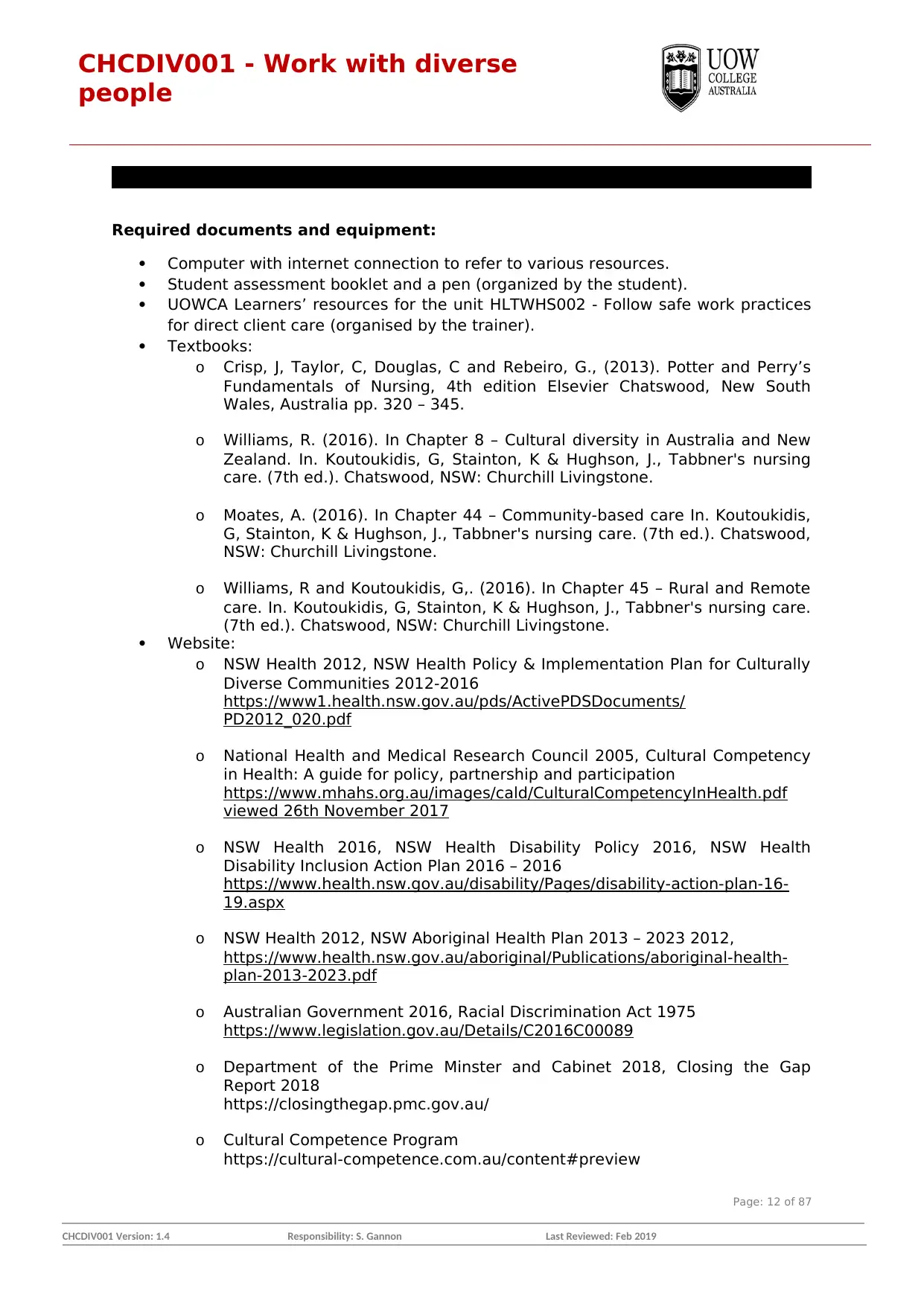
CHCDIV001 Version: 1.4 Responsibility: S. Gannon Last Reviewed: Feb 2019
CHCDIV001 - Work with diverse
people
Assessment task 1: Written Questions
Required documents and equipment:
Computer with internet connection to refer to various resources.
Student assessment booklet and a pen (organized by the student).
UOWCA Learners’ resources for the unit HLTWHS002 - Follow safe work practices
for direct client care (organised by the trainer).
Textbooks:
o Crisp, J, Taylor, C, Douglas, C and Rebeiro, G., (2013). Potter and Perry’s
Fundamentals of Nursing, 4th edition Elsevier Chatswood, New South
Wales, Australia pp. 320 – 345.
o Williams, R. (2016). In Chapter 8 – Cultural diversity in Australia and New
Zealand. In. Koutoukidis, G, Stainton, K & Hughson, J., Tabbner's nursing
care. (7th ed.). Chatswood, NSW: Churchill Livingstone.
o Moates, A. (2016). In Chapter 44 – Community-based care In. Koutoukidis,
G, Stainton, K & Hughson, J., Tabbner's nursing care. (7th ed.). Chatswood,
NSW: Churchill Livingstone.
o Williams, R and Koutoukidis, G,. (2016). In Chapter 45 – Rural and Remote
care. In. Koutoukidis, G, Stainton, K & Hughson, J., Tabbner's nursing care.
(7th ed.). Chatswood, NSW: Churchill Livingstone.
Website:
o NSW Health 2012, NSW Health Policy & Implementation Plan for Culturally
Diverse Communities 2012-2016
https://www1.health.nsw.gov.au/pds/ActivePDSDocuments/
PD2012_020.pdf
o National Health and Medical Research Council 2005, Cultural Competency
in Health: A guide for policy, partnership and participation
https://www.mhahs.org.au/images/cald/CulturalCompetencyInHealth.pdf
viewed 26th November 2017
o NSW Health 2016, NSW Health Disability Policy 2016, NSW Health
Disability Inclusion Action Plan 2016 – 2016
https://www.health.nsw.gov.au/disability/Pages/disability-action-plan-16-
19.aspx
o NSW Health 2012, NSW Aboriginal Health Plan 2013 – 2023 2012,
https://www.health.nsw.gov.au/aboriginal/Publications/aboriginal-health-
plan-2013-2023.pdf
o Australian Government 2016, Racial Discrimination Act 1975
https://www.legislation.gov.au/Details/C2016C00089
o Department of the Prime Minster and Cabinet 2018, Closing the Gap
Report 2018
https://closingthegap.pmc.gov.au/
o Cultural Competence Program
https://cultural-competence.com.au/content#preview
Page: 12 of 87
CHCDIV001 - Work with diverse
people
Assessment task 1: Written Questions
Required documents and equipment:
Computer with internet connection to refer to various resources.
Student assessment booklet and a pen (organized by the student).
UOWCA Learners’ resources for the unit HLTWHS002 - Follow safe work practices
for direct client care (organised by the trainer).
Textbooks:
o Crisp, J, Taylor, C, Douglas, C and Rebeiro, G., (2013). Potter and Perry’s
Fundamentals of Nursing, 4th edition Elsevier Chatswood, New South
Wales, Australia pp. 320 – 345.
o Williams, R. (2016). In Chapter 8 – Cultural diversity in Australia and New
Zealand. In. Koutoukidis, G, Stainton, K & Hughson, J., Tabbner's nursing
care. (7th ed.). Chatswood, NSW: Churchill Livingstone.
o Moates, A. (2016). In Chapter 44 – Community-based care In. Koutoukidis,
G, Stainton, K & Hughson, J., Tabbner's nursing care. (7th ed.). Chatswood,
NSW: Churchill Livingstone.
o Williams, R and Koutoukidis, G,. (2016). In Chapter 45 – Rural and Remote
care. In. Koutoukidis, G, Stainton, K & Hughson, J., Tabbner's nursing care.
(7th ed.). Chatswood, NSW: Churchill Livingstone.
Website:
o NSW Health 2012, NSW Health Policy & Implementation Plan for Culturally
Diverse Communities 2012-2016
https://www1.health.nsw.gov.au/pds/ActivePDSDocuments/
PD2012_020.pdf
o National Health and Medical Research Council 2005, Cultural Competency
in Health: A guide for policy, partnership and participation
https://www.mhahs.org.au/images/cald/CulturalCompetencyInHealth.pdf
viewed 26th November 2017
o NSW Health 2016, NSW Health Disability Policy 2016, NSW Health
Disability Inclusion Action Plan 2016 – 2016
https://www.health.nsw.gov.au/disability/Pages/disability-action-plan-16-
19.aspx
o NSW Health 2012, NSW Aboriginal Health Plan 2013 – 2023 2012,
https://www.health.nsw.gov.au/aboriginal/Publications/aboriginal-health-
plan-2013-2023.pdf
o Australian Government 2016, Racial Discrimination Act 1975
https://www.legislation.gov.au/Details/C2016C00089
o Department of the Prime Minster and Cabinet 2018, Closing the Gap
Report 2018
https://closingthegap.pmc.gov.au/
o Cultural Competence Program
https://cultural-competence.com.au/content#preview
Page: 12 of 87
⊘ This is a preview!⊘
Do you want full access?
Subscribe today to unlock all pages.

Trusted by 1+ million students worldwide
1 out of 86
Related Documents
Your All-in-One AI-Powered Toolkit for Academic Success.
+13062052269
info@desklib.com
Available 24*7 on WhatsApp / Email
![[object Object]](/_next/static/media/star-bottom.7253800d.svg)
Unlock your academic potential
Copyright © 2020–2025 A2Z Services. All Rights Reserved. Developed and managed by ZUCOL.





